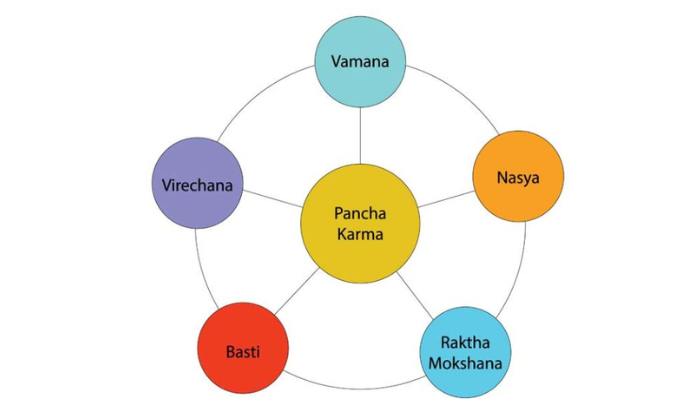
Issue #1 – Many are disillusioned and misled by clinics offering basic treatments like massages and Shirodhara, labeling them as Panchakarma.
Issue #2 – People often seek a quick detox, but after Panchakarma, the body needs time to reset. With the gut becoming sensitive, returning to a hectic, stressful lifestyle too soon can do more harm than good.
Issue #3 – Without proper Purvakarma (pre-treatment) and Paschatkarma (post-treatment), the results can be lukewarm or even negative.
Issue #4 – Many clinics offer Kairalya Panchakarma (External Ayurvedic Therapies) and label them as Panchakarma, misleading clients into thinking they’ve had a full detox.
It’s particularly beneficial for those with chronic diseases, autoimmune disorders, metabolic syndrome, hormonal imbalance and allergies. In these cases, the imbalance in doshas and the accumulation of toxins (ama) has become so severe that diet and Shamana therapy (pacifying doshas with herbs) no longer suffice.
That’s when it’s clear: the toxins need to be expelled, and a more intensive approach is required.
Classical Panchakarma is a comprehensive detox process that spans 5-6 weeks, consisting of several key steps:
The Classical Panchakarma has 5 techniques specifically designed to eliminate toxins (ama) from the body and restore balance. These techniques are:
Virechana – Once toxins are drawn back to the gut, they are eliminated through purgation. This technique is also the go-to method when Pitta is excessive and needs to be expelled.
Vamana– Toxins are expelled through emesis when excess Kapha accumulates in the chest, head, and sinus areas and needs to be cleared.
Vasti – Toxins are expelled via enema when there is an excess of Vata in the system. It is a powerful treatment, especially for pain management, degeneration, and hormonal imbalances. Toxins are removed through Anuvasana Vasti(herbal decoction enemas), alternated with Sneha Vasti(herbal oil enemas) to pacify Vata.
Raktamoksha – This is performed with medical-grade leeches when Pitta in the blood is involved, particularly in cases of skin problems.
Nasya – A potent nasal procedure used to balance hormones, neurotransmitters, clear sinuses, and build immunity. Toxins are expelled through herbal decoctions or powders, and doshas are pacified with herbal oils.
For noticeable results in chronic conditions, 2-3 sessions of Classical Panchakarma are typically needed. However, it’s important to remember only one session can be done per year.
It cannot be stressed enough—after Classical Panchakarma, allowing 2-3 months for full healing and gradually returning to normal eating is crucial.
These therapies are used for
These therapies do not expel toxins from the body, the way Classical Panchkarma does.
It is suitable for individuals who may not be able to undergo the intense cleansing of classical Panchakarma. It’s ideal for:
Be proactive—if there’s swelling, inflammation, or toxins, ensure the clinic uses herbal decoctions or powders, not oils, especially for chronic issues.
The duration typically ranges from 3 to 7 sessions, depending on the severity of the condition. For optimal results, sessions should be spaced on alternate days.
1. Pain Management
For conditions like back pain, muscle stiffness, frozen shoulder, arthritis, sciatica, etc.
Therapies follow a specific order based on the issue:
2. Stress Management – Aids in reducing mental stress, anxiety, and promotes emotional balance.
3. Weight Management
4. Maintenance of Sense Organs
These therapies yield the best results when combined with internal herbs. For chronic problems, Classical Panchakarma remains the most effective approach.
If you have chronic health problems and need a deep detox then Classical Panchakarma is the way to go, while External Ayurvedic Therpies- i.e. Kairalya Panchakarma for maintaining health, balancing doshas, and providing relief from pain, stress, and fatigue.
Simmi Chopra is a highly accomplished Ayurvedic Practitioner with a unique blend of expertise in traditional Ayurveda and modern science. Trained in the ancient healing system, she completed the prestigious Ayurveda Doctor program from Kerala Ayurveda. Based in New York City, Simmi practices at SIDH Ayur, where she offers personalized Ayurvedic therapies, dietary guidance, lifestyle recommendations, and herbal solutions to help clients achieve holistic balance. Check out her YouTube link – https://youtu.be/5wwBKHj2h1I